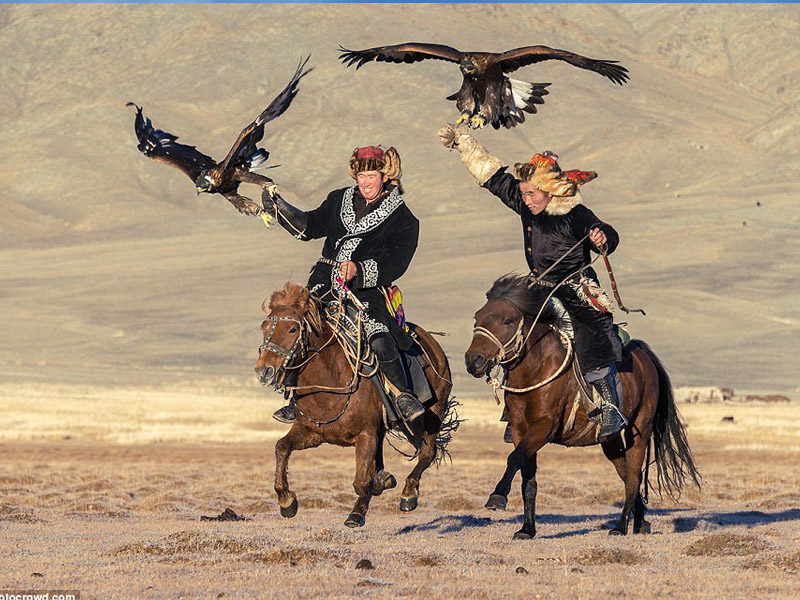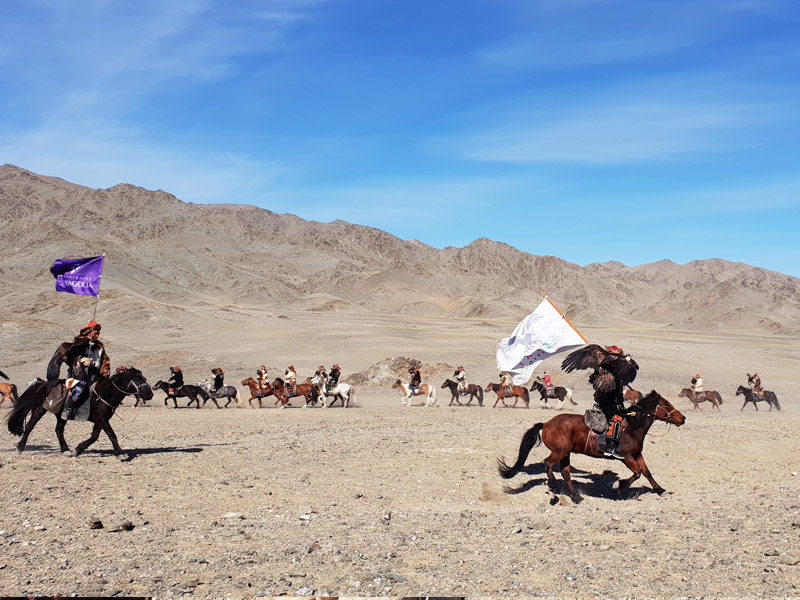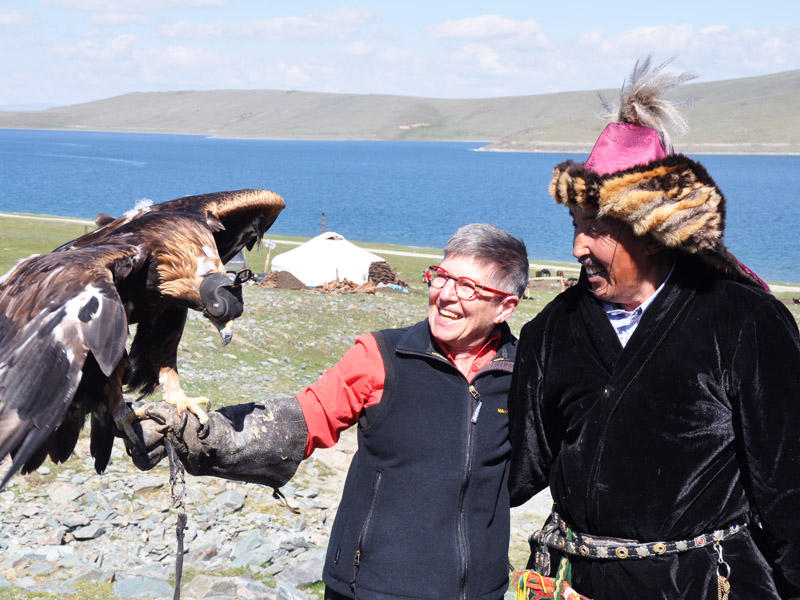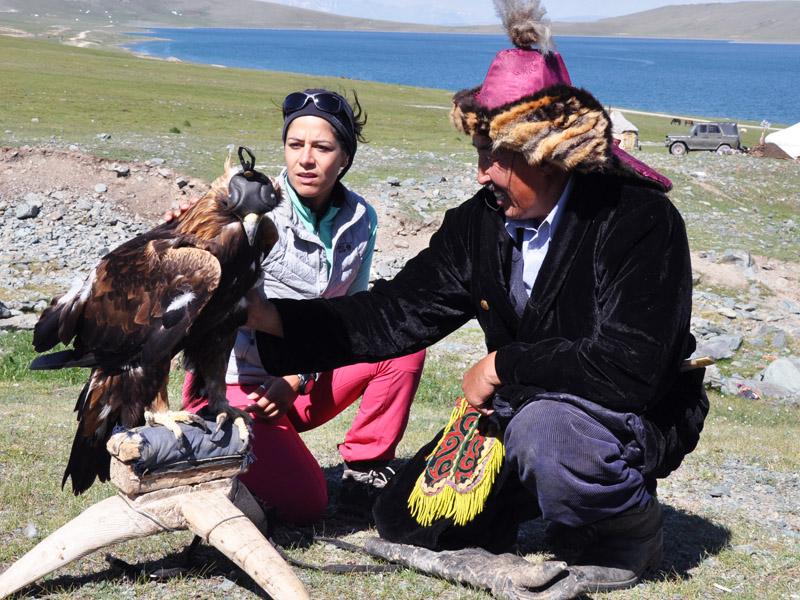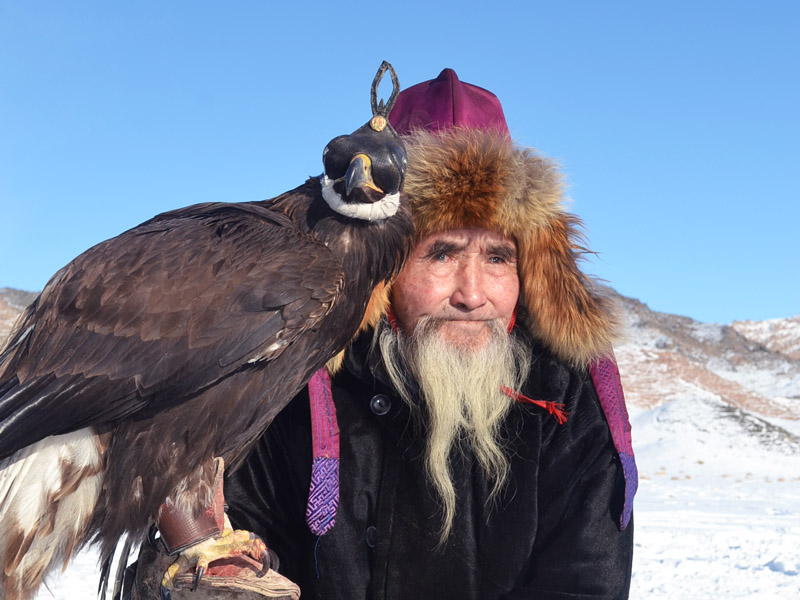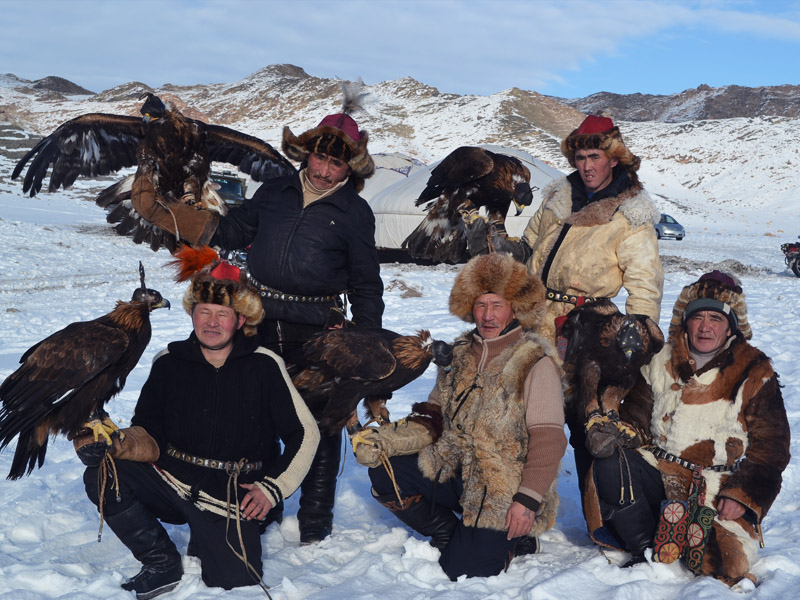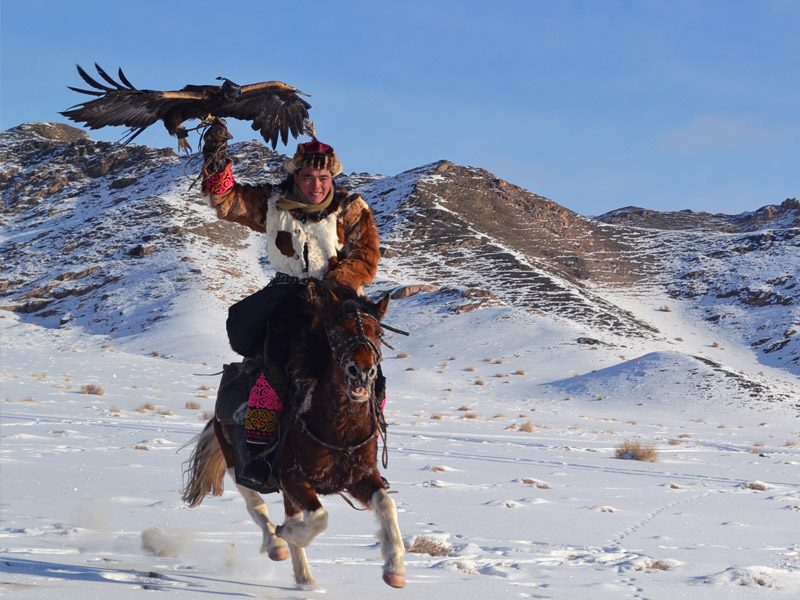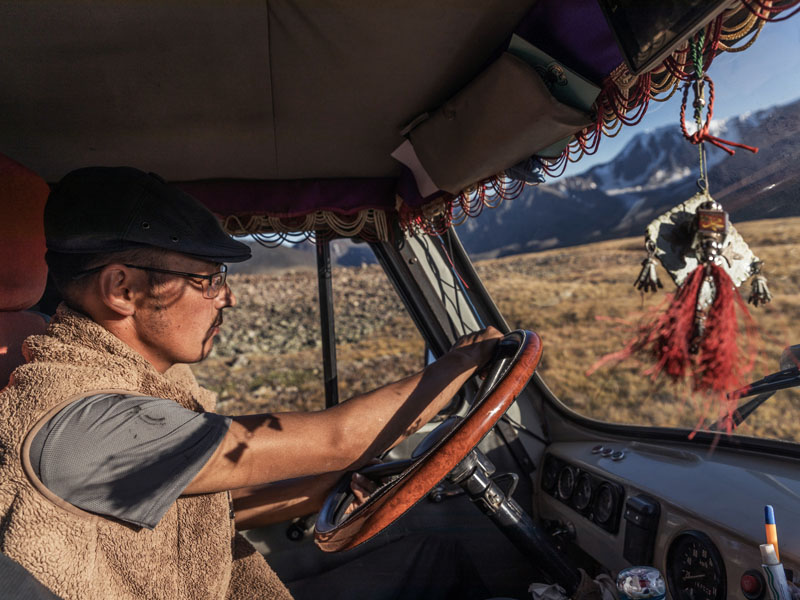Golden Eagle Festival with Altai Tavan Bogd NP
Festival tours
It is recognized as a UNESCO World Heritage Cultural Event
- Duration 9 days
- Physical rating Easy
- Group size 2-12 Pax
Overview
For those of you who are interested in The Golden Eagle Festival…
We offer you the opportunity to experience the two-day festival by itself, or choose to include either the pre-festival or post-festival extension of the Altai Tavan Bogd National Park Sightseeing Tour.
The Altai Tavan Bogd National Park is named after the tallest five peaks of Mongolia. Tavan Bogd meaning the “Five Saints” - are part of the Altai Mountain range. Parts of this massive range also extend into the countries of China, Russia, and Kazakhstan. Located in the country’s remote far west, Tavan Bogd National Park offers some of the most gorgeous, pristine spots in all of Mongolia. Here you will come across fast-flowing mountain rivers, scenic lakes with backdrops of towering snow-capped mountains, and immense glaciers.
The Golden Eagle Festival in Mongolia has been the largest gathering of eagle hunters and their eagles in the world since it started in 1999. It is recognized as a UNESCO World Heritage Cultural Event. This two-day festival takes place in the country’s remote, far west - home to the nation’s largest ethnic minority group. The Kazakhs have preserved their age-old nomadic culture, including their heritage of training and hunting with eagles - the largest and most powerful of raptors. The festival commences with a parade of mounted hunters dressed in traditional attires with their majestic golden eagles on their arms, followed by a series of games. The events are: eagle catching fox skin dragged behind a horse, eagle returning to their owner’s arm from a distance on command, and Kazakh games of tiyn teru - coin grab from the ground while riding on horseback, kyz kuar - woman whips the man while both are galloping on horseback, and kukbar - tug of war over a goatskin while on horseback. You’ll also get a chance to hear vibrant, traditional Kazakh music and taste hearty local dishes.
The Eagle Festival is a large-scale event that takes place once a year, so it is in high demand. We recommend our customers to make a reservation as early as possible. The reason is that the prices of domestic flights and hotel reservations increase rapidly as the Eagle Festival approaches, which increases the cost for our customers.
Tour Gallery
Dates & Prices
Price Included
- Golden Eagle Festival tax
- All meals during the trip
- Drinking water
- All accommodations during the program
- Transportation, including gasoline
- All airport transfers
- Local guide
- Local flights (Ulaan Baatar - Ulgii - Ulaan Baatar)
Price Excluded
- International Flights
- Visa
- Travel Insurance
- Charges for excess baggage
- Airport taxes
- Individual equipment
- Drinks and extra charges in hotels and inns
- All alcoholic drinks
- All costs not specified in “Included”
Itinerary
- 3 overnights in local hotel or ger camp in Ulgii
- 5 tented overnights
-
Day 1
Fly to western Mongolia
Fly to Ulgii, capital of Bayan-Ulgii province in westernmost Mongolia. This is the highest province and home to the country’s tallest peaks - the snow-capped Altai Mountains. Bayan-Ulgii is Mongolia’s only Kazakh-majority province with Kazakh people making up about 90% of the population. Although Kazakhs and Mongols both share nomadic roots and practice a similar way of life centered around horses and livestock herding, there are some distinctions. For example, the Kazakh language is part of the Turkic language family whereas Mongolian is a Mongolic language. Kazakh culture is influenced by Islamic traditions whereas Mongolian culture is influenced by TIbetan Buddhism. The colorful ornaments inside a Kazakh ger (yurt) and designs of the traditional clothes are quite different to their Mongolian counterpart as well.
-
Day 2
Drive to Dayan Lake
Today we’ll drive to Dayan Lake. On the way, we’ll see Bronze Age deer stones as well as Turkic period human-shaped stones dating from the 6th to 8th century AD. The landscape around Dayan Lake is ideal with forests, mountains, and rivers. The area is a sanctuary for migratory birds. Early evening, we’ll meet with our nomadic Kazakh family. Stay overnight in a Kazakh ger (yurt) with one of the families or in a tent. Today’s drive is about 150 km.
-
Day 3
Drive to Khoton-Khurgan Lakes
Today we’ll drive to Khoton and Khurgan Lakes, stopping for lunch on the way, and spend the night at a camping site on Biluut Hill. Here you will find ancient rock carvings dating from 1500 to 2000 years ago. These two lakes are connected by a wide channel, and situated at 2,000 meters ASL at the foot of the Altai Mountains. The landscape around these pristine lakes is picturesque with a backdrop of majestic snow-capped mountains. Today’s drive is about 90 km.
-
Day 4
Drive to White River Valley
Drive to Tsagaan Gol (White River) Valley. We’ll have a chance to visit Tuvan people, who are another minority group within Mongolia. Tuvans are livestock-herding nomads who practice shamanism. Like the Mongols, Tuvans are famous for their throat-singing heritage. Today’s drive is about 200 km.
-
Day 5
Head to Shiveet Mountain
Mountains are sacred for nomadic cultures. Shiveet Mountain is sacred for the local Tuvan people, who forbid the act of hunting around this area. Due to this, there has been a growth in the number of ibex (mountain goats) and sometimes it is possible to see 50-100 of them at once. There are three large petroglyphic complexes in the Mongolian Altai, which are inscribed on the World Heritage List. One of them is here at Shiveet Mountain. The petroglyphs here date from pre-Bronze Age to the Turkic period, and display an array of interesting and rare images.
-
Day 5
Return to Ulgii
Drive back to Ulgii. In the afternoon, you may choose to visit our arts and handicrafts shop, which supports locals by creating jobs such as helping women earn income from home while looking after their children. Tonight, stay at our own-run Ger Camp or our hotel named the Eagle’s Nest.
-
Day 7-8
The Eagle Festival
The art of falconry has been practiced in different parts of the world since ancient times. Birds of prey - falcons, hawks, and eagles - are kept and trained from a young age to hunt wild animals, initially out of necessity for meat and pelts. While the exact time and origin of this tradition is unknown, it became well established in Asia and the Middle East around 4,000 years ago and later spread out to neighboring regions along cultural and trade links, known as the Silk Roads, throughout different time periods.
The Kazakhs in the rugged mountains of western Mongolia have kept alive this special bond between human and bird for centuries - hunting from horseback with majestic golden eagles. To preserve this cultural heritage from going extinct in the rapidly changing modern times, the Golden Eagle Festival was first founded in 1999 at the province of Bayan-Ulgii in Mongolia’s far west. Now, Mongolia has the world’s most number of eagle hunters, so you could call this province, “the world’s center of eagle hunters.” The annual Golden Eagle Festival takes place in early October; and since its beginning, two smaller festivals have been added, both taking place in September. In 2011, it was recognized as a UNESCO World Heritage Cultural Event.
The two day festival opens with a parade of participants dressed in their traditional hunting outfits on horseback with their majestic golden eagles on their arms. The eagle trainers are also rated by the judges for “who is the best dressed” and “who has the best groomed horse.” The speed, agility, and accuracy of the eagles are displayed and tested during the main two games. One, when the eagle is released from a cliff to glide down and grip a bait being dragged behind horseback. And another, when the eagle is released from a cliff while its trainer on horseback calls it to land on his/her arm. Additional games are: kukbar - a goatskin tug-of-war between two men on horseback, tiyn teru - coin grab from ground while galloping on horse, and kyz kuar - woman whipping man while chasing on horseback.
In the late afternoon of the final day, winners of the festival will be announced during the awards ceremony. In the evening of one of the nights, we can enjoy a concert of traditional music at the theater in the center of Ulgii. Share a farewell dinner as a celebratory conclusion for an eventful two-days.
-
Day 9
Fly to Ulaanbaatar
Fly to the country’s capital of Ulaanbaatar. Upon landing, meet our representative and get transferred to your hotel. Home for nearly half of the country’s population, Ulaanbaatar is the nation’s hub. The city reveals traces of its historical periods through its blend of modern glass buildings, Soviet-era architecture, TIbetan Buddhist monasteries, and the ger (yurt) districts spread out on the outskirts. The central square with a statue of Genghis Khan seated on his throne in front of the Parliament Building is worth a visit. If you have some time, there are a number of shops and museums to keep you busy.
